Stocks continued lower with modest losses in the major index ETFs. The Nasdaq 100 ETF (QQQ) led the way lower with a .81% decline. Eight of nine sectors moved lower with energy and technology leading the way. The defensive sectors held up the best with the utilities sector providing the only gain. Overbought homebuilders took the biggest hit on Wednesday as the Home Construction iShares (ITB) plunged around 3.5%. Notice that ITB formed a spinning top four days ago and a bearish engulfing three days ago. The decline over the last two days confirmed this bearish engulfing and next support is set in the 18 area.
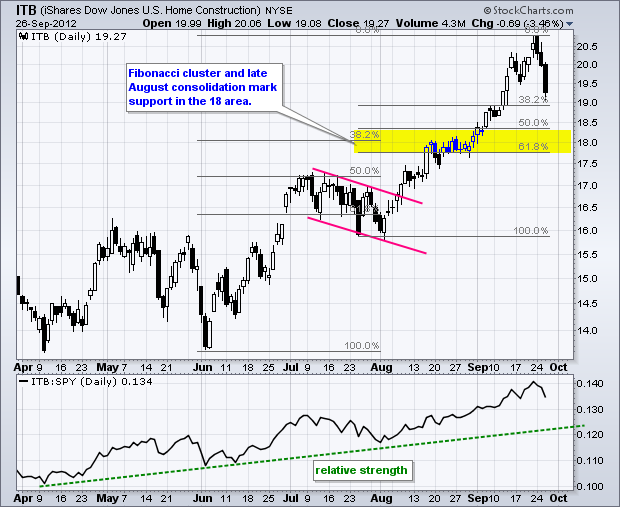

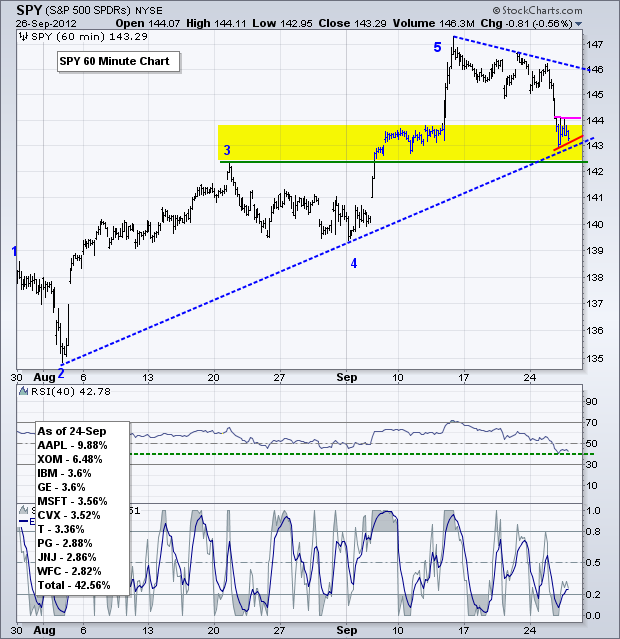
With a decline to the 143 area, the S&P 500 ETF (SPY) is setting up for its first significant support test. Broken resistance, the early September consolidation and the early August trend line converge to mark support here. SPY basically plunged from 146 to 143 and then consolidated in the 143-144 area yesterday. A break below this small consolidation would signal a continuation lower and target a move to the next support zone around 139-140. RSI is also testing its support zone as it trades in the 40-50 area. A break below 40 would turn short-term momentum bearish.

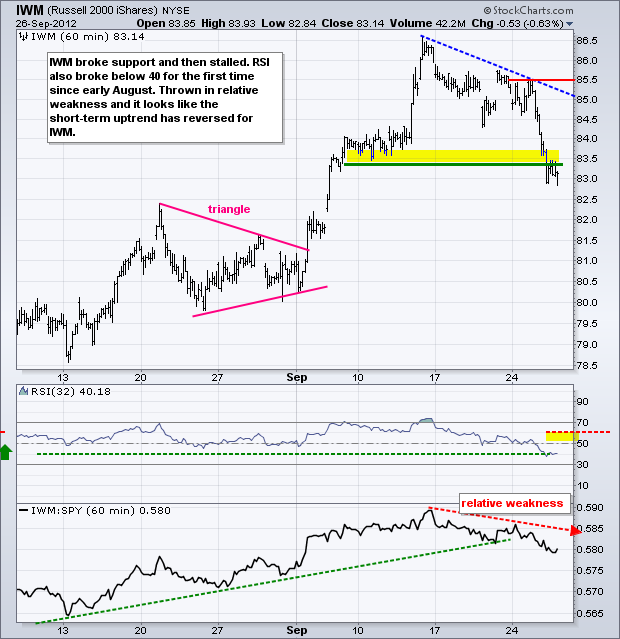
**************************************************************************
No change. The 20+ Year T-Bond ETF (TLT) flashed the warning sign last week with a fairly sharp advance back above 121. This uptrend continued this week as TLT surged above 123.50 on Tuesday and above 125 on Wednesday. Money moving into treasuries is money that is not available for stocks and other riskier assets. Moreover, the decline in treasury yields points to weakness in the economy (perhaps third quarter earnings). I am marking support at 122 for TLT.
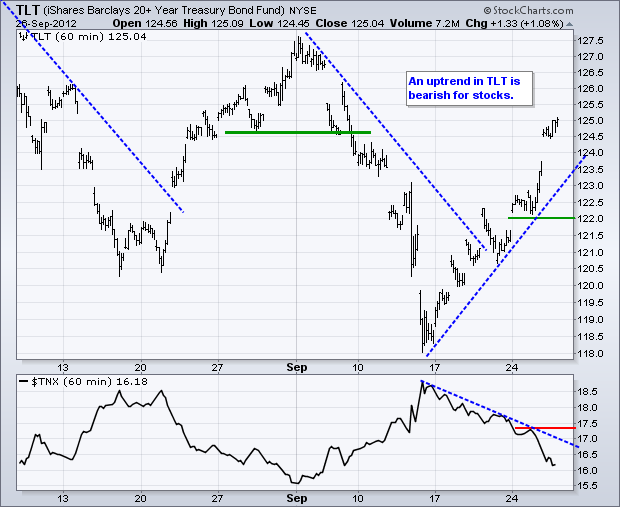
**************************************************************************
No change. The US Dollar Fund (UUP) has been positively correlated with US Treasuries. This makes sense because both rise when the risk trade is on and both fall when the risk trade is off. The risk trade has been off since mid September as UUP bottomed and bounced from oversold levels. The overall trend remains down with resistance marked in the 22.10 area. With the slow rise over the last two weeks, I can mark short-term support at 21.68, a break of which would signal a continuation of the downtrend.
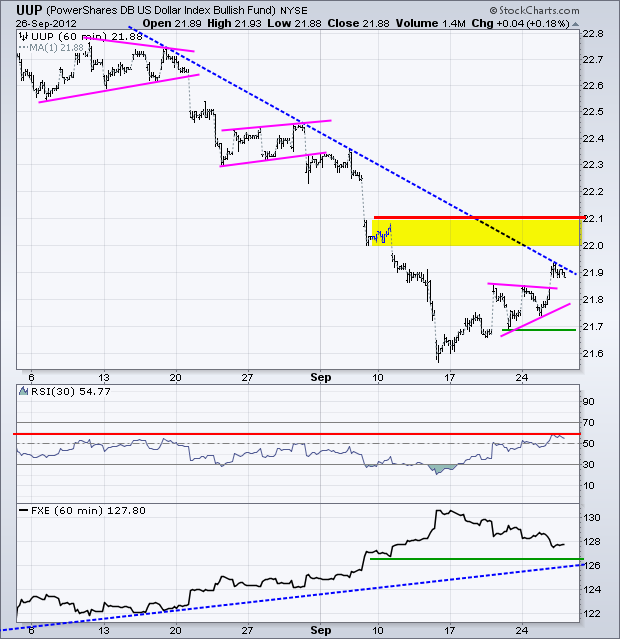
**************************************************************************
No change. The US Oil Fund (USO) broke down last week, bounced on Thursday-Friday and continued lower this week. An overall trend is clearly down, but oil is getting short-term oversold after an 8% decline in one week. Broken support turns into first resistance in the 35-35.5 area. RSI resistance is set in the 50-60 area.
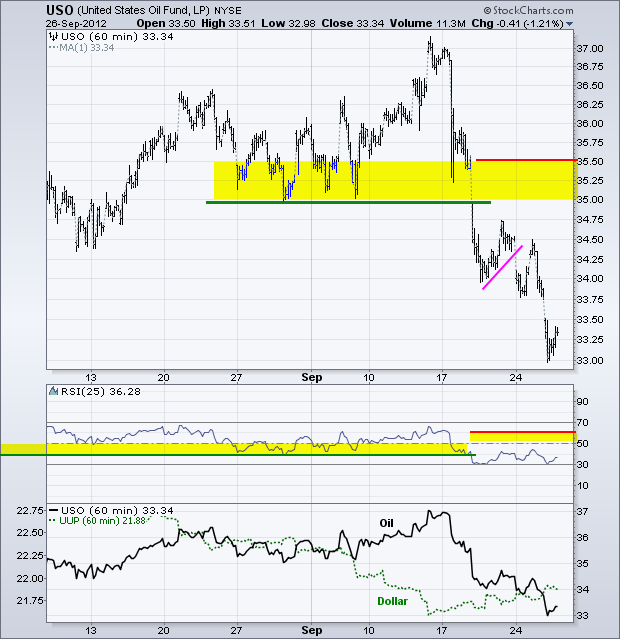
**************************************************************************
The Gold SPDR (GLD) broke first support at 170 and then rebounded back to the support break. As noted before, I am not putting to much emphasis on support at 170 and prefer to focus on support at 167 for a trend reversal.

**************************************************************************
Key Reports and Events:
Thu - Sep 27 - 08:30 - Jobless Claims
Thu - Sep 27 - 08:30 – Durable Goods Orders
Thu - Sep 27 - 08:30 – GDP
Thu - Sep 27 - 10:00 - Pending Home Sales
Fri - Sep 28 - 08:30 - Personal Income & Spending
Fri - Sep 28 - 09:45 - Chicago PMI
Fri - Sep 28 - 09:55 - Michigan Sentiment
Sat – Oct 06 – 09:00 – EU Summit
Charts of Interest: Tuesday and Thursday
This commentary and charts-of-interest are designed to stimulate thinking. This analysis is not a recommendation to buy, sell, hold or sell short any security (stock ETF or otherwise). We all need to think for ourselves when it comes to trading our own accounts. First, it is the only way to really learn. Second, we are the only ones responsible for our decisions. Think of these charts as food for further analysis. Before making a trade, it is important to have a plan. Plan the trade and trade the plan. Among other things, this includes setting a trigger level, a target area and a stop-loss level. It is also important to plan for three possible price movements: advance, decline or sideways. Have a plan for all three scenarios BEFORE making the trade. Consider possible holding times. And finally, look at overall market conditions and sector/industry performance.

About the author:
Arthur Hill, CMT, is the Chief Technical Strategist at TrendInvestorPro.com. Focusing predominantly on US equities and ETFs, his systematic approach of identifying trend, finding signals within the trend, and setting key price levels has made him an esteemed market technician. Arthur has written articles for numerous financial publications including Barrons and Stocks & Commodities Magazine. In addition to his Chartered Market Technician (CMT) designation, he holds an MBA from the Cass Business School at City University in London.
Learn More





